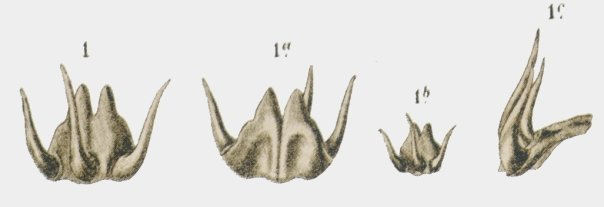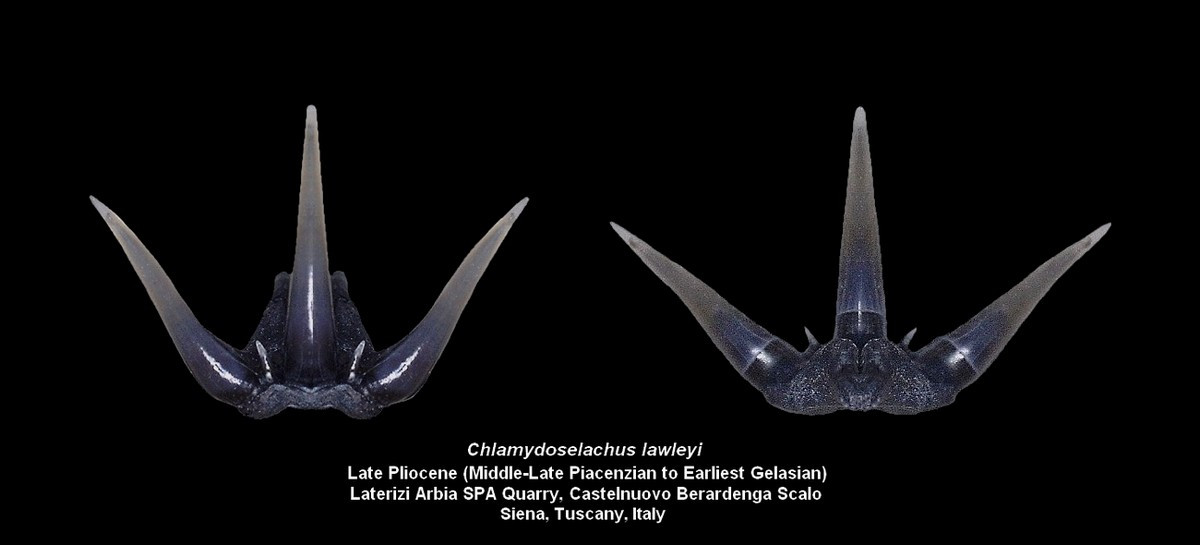Chlamydoselachus lawleyi
Davis, 1887
Classification: Elasmobranchii Hexanchiformes Chlamydoselachidae
Reference of the original description
Note on a fossil species of Chlamydoselachus. Proceedings of the Zoological Society of London, 1887, 542–544
Note on a fossil species of Chlamydoselachus. Proceedings of the Zoological Society of London, 1887, 542–544
Image of the original description

Chlamydoselachus lawleyi Davis, 1887, original image of Lawley, 1876

Chlamydoselachus lawleyi Davis, 1887, original image of Lawley, 1876
Synonyms / new combinations and misspellings
Chlamydoselachoides lawleyi, Chlamydoselachus aff. lawleyi, Chlamydoselachus cf. lawleyi
Chlamydoselachoides lawleyi, Chlamydoselachus aff. lawleyi, Chlamydoselachus cf. lawleyi
Description:
Citation: Chlamydoselachus lawleyi Davis, 1887: In: Database of fossil elasmobranch teeth www.shark-references.com, World Wide Web electronic publication, Version 12/2025
Please send your images of "Chlamydoselachus lawleyi" to info@shark-references.com

Chlamydoselachus lawleyi Davis, 1887; Late Pliocene, Laterizi Arbia SPA Querry, Castelnuovo Berardenga Scalo, Seine, Tuscany, Italy. Collection and © Adam Anderson

Chlamydoselachus lawleyi Davis, 1887; Late Pliocene, Laterizi Arbia SPA Querry, Castelnuovo Berardenga Scalo, Seine, Tuscany, Italy. Collection and © Adam Anderson
Distribution Geographic
type locality: Orciano, Pisa province, Italy [1396];
other localities: Castelnuovo Berardenga Scalo, Siena province, Italy [4797]; Agrigento, Sicilian, Italy, 4 km E near the road 115 [1886]; Potamida, Kissamos, Chania, West Crete [1886];
Distribution of Chlamydosechidae show google map
type locality: Orciano, Pisa province, Italy [1396];
other localities: Castelnuovo Berardenga Scalo, Siena province, Italy [4797]; Agrigento, Sicilian, Italy, 4 km E near the road 115 [1886]; Potamida, Kissamos, Chania, West Crete [1886];
Distribution of Chlamydosechidae show google map
Distribution Stratigraphy
dark grey marl clay of Orciano, Lower Pliocene, Zanclien [1886]; Piacenzian-earliest Gelasian of Tuscany (Castelnuovo Berardenga Scalo, Siena province, Italy) [4797]; dark grey marl clay of Agrigento, Lower Pliocene, Zanclien [1886]; dark grey marl clay of Potamida, Lower Pliocene, Zanclien [1886];
dark grey marl clay of Orciano, Lower Pliocene, Zanclien [1886]; Piacenzian-earliest Gelasian of Tuscany (Castelnuovo Berardenga Scalo, Siena province, Italy) [4797]; dark grey marl clay of Agrigento, Lower Pliocene, Zanclien [1886]; dark grey marl clay of Potamida, Lower Pliocene, Zanclien [1886];
Material
type material: 9 teeth LAWLEY, 1876, [1396]; a hundred teeth (CZ-TES 2, 1-98, deposited: Centro civico Ofelia Mangini, Scandicci, Piazza Vittorio Veneto n.1, 50010 Badia a Settimo, Scandicci, Firenze, Italy.) [4797]; one tooth (BSP 1982 IX 108) [1886]; two teeth (BSP 1982 IX 109, BSP 1982 IX 110) [1886];
type material: 9 teeth LAWLEY, 1876, [1396]; a hundred teeth (CZ-TES 2, 1-98, deposited: Centro civico Ofelia Mangini, Scandicci, Piazza Vittorio Veneto n.1, 50010 Badia a Settimo, Scandicci, Firenze, Italy.) [4797]; one tooth (BSP 1982 IX 108) [1886]; two teeth (BSP 1982 IX 109, BSP 1982 IX 110) [1886];
Description
Original description LAWLEY, 1876, p.87 [1396]: Come si vede nella fig., 1", la radice ha due rami, è quasi saldata per tutta la sua lunghezza, ma sul davanti, giust'appunto nella sua saldatura, sorge il dente centrale come nella fig. 1, e forma con i due laterali tutto un dente; il loro apice cambia di colore atteso essere tutto dentrina ed è trasparente; i denti sono flessuosi, fig. lc, e la radice fa quasi angolo retto con essi. Di questi denti ne possedo due perfettamente completi, e sette più o meno mutilati, ma tutti egualmente conformati, e riconoscibili: mi provengono tutti da Orciano, dove sembrano rarissimi. Per quanto io abbia osservato, non mi è stato possibile di vedere un dente simile ne' viventi, nè rappresentato in disegno nè di pesci nè di rettili.
Original diagnosis DAVIS, 1887 [627]: Leaving this extremely problematical relationship of Chlamydoselachus to be substantiated or otherwise by future investigation, it is extremely interesting to find that ten years ago a fossil representative of Chlamydoselachus was actually discovered and figured by the late Robert Lawley. The specimen is from the Pliocene beds of Orciano in Tuscany, and is described as very rare; the teeth figured are possessed of three sharp, slender, backwardly-curved denticles, with a base forming a broadly expanded plate divided at its posterior extremity into a pair of prongs, which doubtless extended, as in the existing species, beneath the succeeding tooth, thereby gaining additional firmness and strength. The figures indicate a tooth twice the diameter of the anterior teeth of the existing species. The author knew of no living or fossil representative of the teeth, and gave the figure with a short notice, without description or appending to it any distinctive name. There can be no hesitation therefore in associating the fossil with the existing genus, and it may not be inappropriate to append the name of Mr. Lawley and distinguish it specifically, Chlamydoselachus lawleyi. The figures will be found in 'Nuovi Studi sopra ai Pesci ed altn Vertebrati fossili delle colline Toscane,' di Roberto Lawley, published at Florence in 1876, pl. i. figs. 1-1c. I am indebted to Mr. (x. A. Boulenger for the opportunity of comparing them with the teeth of the recent Chlamydoselachus in the British Museum.
Original description LAWLEY, 1876, p.87 [1396]: Come si vede nella fig., 1", la radice ha due rami, è quasi saldata per tutta la sua lunghezza, ma sul davanti, giust'appunto nella sua saldatura, sorge il dente centrale come nella fig. 1, e forma con i due laterali tutto un dente; il loro apice cambia di colore atteso essere tutto dentrina ed è trasparente; i denti sono flessuosi, fig. lc, e la radice fa quasi angolo retto con essi. Di questi denti ne possedo due perfettamente completi, e sette più o meno mutilati, ma tutti egualmente conformati, e riconoscibili: mi provengono tutti da Orciano, dove sembrano rarissimi. Per quanto io abbia osservato, non mi è stato possibile di vedere un dente simile ne' viventi, nè rappresentato in disegno nè di pesci nè di rettili.
Original diagnosis DAVIS, 1887 [627]: Leaving this extremely problematical relationship of Chlamydoselachus to be substantiated or otherwise by future investigation, it is extremely interesting to find that ten years ago a fossil representative of Chlamydoselachus was actually discovered and figured by the late Robert Lawley. The specimen is from the Pliocene beds of Orciano in Tuscany, and is described as very rare; the teeth figured are possessed of three sharp, slender, backwardly-curved denticles, with a base forming a broadly expanded plate divided at its posterior extremity into a pair of prongs, which doubtless extended, as in the existing species, beneath the succeeding tooth, thereby gaining additional firmness and strength. The figures indicate a tooth twice the diameter of the anterior teeth of the existing species. The author knew of no living or fossil representative of the teeth, and gave the figure with a short notice, without description or appending to it any distinctive name. There can be no hesitation therefore in associating the fossil with the existing genus, and it may not be inappropriate to append the name of Mr. Lawley and distinguish it specifically, Chlamydoselachus lawleyi. The figures will be found in 'Nuovi Studi sopra ai Pesci ed altn Vertebrati fossili delle colline Toscane,' di Roberto Lawley, published at Florence in 1876, pl. i. figs. 1-1c. I am indebted to Mr. (x. A. Boulenger for the opportunity of comparing them with the teeth of the recent Chlamydoselachus in the British Museum.
References

Deep-sea elasmobranch fauna with the first descriptions of genera Arynchobatis and Pseudoraja from the Miocene Yatsuo group in Toyama, central Japan. Historical Biology, 32(8), 1120–1142
DOI: 10.1080/08912963.2019.1566325

A small fossil fish fauna, rich in Chlamydoselachus teeth, from the Late Pliocene of Tuscany (Siena, central Italy). Cainozoic Research, 6(1–2), 3–23
Systematic, paleoecologic and paleobiogeographic analysis of the Plio-Pleistocene Mediteranean elasmobranch fauna. Atti Societa Toscana Scienze Naturali, Serie A, 113: 81–88

A deep water elasmobranch fauna from a lower Pliocene outcropping (Northern Italy). In Uyeno, T. & Arai, R. & Taniuchi, T. & Matsuura, K. (Eds) Proceedings of the second international conference on Indo-Pacific fishes. Ichthyological Society of Japan, Tokyo: 133–139

Zahnmorphologische Untersuchungen an rezenten und fossilen Haien der Ordnungen Chlamydoselachiformes und Echinorhiniformes. Palaeo Ichthyologica, 1, 1–315

Late Cretaceous and Cenozoic Squalomorphii of the Northwest Pacific Ocean. PhD, Univ. of California Berkeley, 553 p., 71 fig.

New taxonomic names of fish-like vertebrates. Notulae Naturae, 187, 1–16
VI. The anatomy of the frilled shark Chlamydoselachus anguineus Garman. Bashford Dean Memorial, Volume Archaic Fishes, 331–520
V. The Natural History of the Frilled Shark, Chlamydoselachus anguineus. Bashford Dean Memorial, Volume Archaic Fishes, 243–330

Deep-sea elasmobranch fauna with the first descriptions of genera Arynchobatis and Pseudoraja from the Miocene Yatsuo group in Toyama, central Japan. Historical Biology, 32(8), 1120–1142
DOI: 10.1080/08912963.2019.1566325

A small fossil fish fauna, rich in Chlamydoselachus teeth, from the Late Pliocene of Tuscany (Siena, central Italy). Cainozoic Research, 6(1–2), 3–23
Systematic, paleoecologic and paleobiogeographic analysis of the Plio-Pleistocene Mediteranean elasmobranch fauna. Atti Societa Toscana Scienze Naturali, Serie A, 113: 81–88

A deep water elasmobranch fauna from a lower Pliocene outcropping (Northern Italy). In Uyeno, T. & Arai, R. & Taniuchi, T. & Matsuura, K. (Eds) Proceedings of the second international conference on Indo-Pacific fishes. Ichthyological Society of Japan, Tokyo: 133–139

Zahnmorphologische Untersuchungen an rezenten und fossilen Haien der Ordnungen Chlamydoselachiformes und Echinorhiniformes. Palaeo Ichthyologica, 1, 1–315

Late Cretaceous and Cenozoic Squalomorphii of the Northwest Pacific Ocean. PhD, Univ. of California Berkeley, 553 p., 71 fig.

New taxonomic names of fish-like vertebrates. Notulae Naturae, 187, 1–16
VI. The anatomy of the frilled shark Chlamydoselachus anguineus Garman. Bashford Dean Memorial, Volume Archaic Fishes, 331–520
V. The Natural History of the Frilled Shark, Chlamydoselachus anguineus. Bashford Dean Memorial, Volume Archaic Fishes, 243–330


















